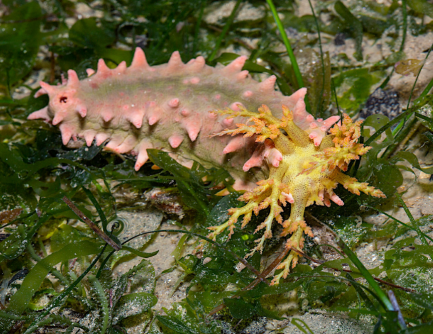Newswise — Russian biologists from A.V. Zhirmunsky National Scientific Center of Marine Biology, Far Eastern Branch, Russian Academy of Sciences have analyzed about 200 articles dedicated to composition of connective tissue (Extracellular Matrix) of echinoderms. That has enabled them for the first time to compare the composition of extracellular matrix of echinoderms and vertebrates. The work is published in Marine Drugs journal.
Echinoderms have unique for animals ability to change physical integrity of connective tissue. For example, holothurians (sea cucumbers) thanks to it can make their body hard, or on the contrary, soft. Analysis of genomes of echinoderms showed, that connective tissue of these animals has rather complex organization. It includes a wide range of structural proteins of extracellular matrix, and also various proteases and their inhibitors. The base of the connective tissue form representatives of almost all main groups of collagens, various glycoproteins and proteoglycans. It also has enzymes of synthesis of structural proteins and their modifications by polysaccharides. In that respect the composition of connective tissue of echinoderms and vertebrates in many similar.
Groups of collagens that are present in echinoderms’ organisms are rather diverse. In particular fibril-forming collagens probably constitute the base of extracellular matrix. Other types of collagens (FACIT and multiplexins), as their homologues in vertebrates, can participate in forming of net and give connective tissue different features.
The peculiarity of echinoderms consists in the fact that they don’t have elastin. This is a protein, that together with collagens form the base of connective tissue in vertebrates’ organisms. That’s why there is another structural protein that is very important – fibrillin. More attention should be paid to study of its structure and functions in organisms of vertebrates.
Echinoderms have a wide diversity of proteinases, among which scientists identify serine, cysteine, asparaginic and metallopeptidases. Their active centers have a typical structure and are able to split different molecules of extracellular matrix. Echinoderms are also characterized by a wide range of inhibitors of proteinases.
Scientists suggested that complex structure of extracellular matrix and diversity of intermolecular relations probably explain the complexity of mechanisms that answer for change of mechanic properties of connective tissue of echinoderms. These mechanisms may depend not only on the amount of cross bonds between molecules, but also on composition of connective tissue and properties of its proteins.
Results of their work will be useful for further researches of connective tissue of echinoderms, and particularly of its mechanical properties. The study of mechanical properties of connective tissue enables to create new materials that can find use, for example, in biomedicine.
